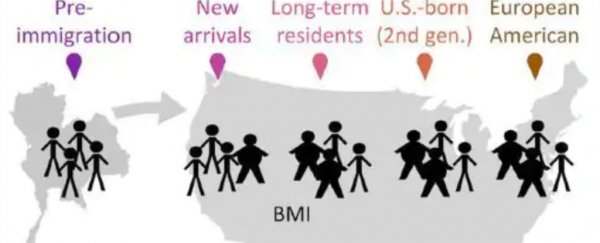An empire of germs dwells inside you, trillions strong. About a half-pound of bacteria plus their genes make up our microbiome.
Though each microbe is small, a healthy and diverse microbiome is mighty. Its influence, studies suggest, spans the human condition — from mood swings to weight gain.
The microbiome begins as a departing gift from mothers at birth, but many factors alter its composition.
Growing evidence shows location has a profound impact on the diversity of microbes, and some places are much less diverse than others.
A study published this week in the journal Cell follows multi-generation immigrants from Southeast Asia to the United States. As they moved, their microbes responded.
Once in the United States, the immigrants' gut diversity dropped to resemble the less-varied microbiomes in European Americans. At the same time, obesity rates spiked.
"We found that moving to a new country changes your microbiome," said Dan Knights, a computational microbiologist at the University of Minnesota and an author of the paper.
 (Cell) (Britton, Carly (ELS-CMA))
(Cell) (Britton, Carly (ELS-CMA))
"You pick up the microbiome of the new country and possibly some of the new disease risks that are more common in that country."
In the United States, immigrants in the study ate foods richer in sugars, fats and protein. Microbiomes changed within months of moving.
"People began to lose their native microbes almost immediately after arriving in the U.S.," Knights said.
"The loss of diversity was quite pronounced: Just coming to the USA, just living in the USA, was associated with a loss of about 15 percent of microbiome diversity."
Obesity rates among many of the study immigrants increased sixfold. Those who became obese also lost an additional 10 percent of their diversity.
"And the children of immigrants," Knights said, "had yet again another 5 to 10 percent loss."
As microbial diversity decreases, the risk of diseases such as obesity and diabetes increases.
"It's been known from previous studies that people in developing nations tend to have more gut microbiome diversity and lower risk of metabolic diseases," Knights said.
"It was also known that moving from a developing nation to the U.S. increases your risk of those diseases."
But no one had tested whether the microbiome changed after immigration, too.
"The association made between changes in dietary factors, toward a more 'Westernized' nutritional diet, and the loss of bacterial diversity" was "particularly striking," said Eran Elinav, who studies the human microbiome at the Weizmann Institute of Science in Israel.
(In 2014, Elinav and his colleagues reported that traveling to distant time zones by plane alters the microbiome, as though the germs were jet-lagged.)
But changes in diet were slower than changes in microbiome, suggesting factors beyond American food were at play.
"We found that diet alone wasn't enough to explain the rapid Westernization of the microbiome," Knights said — differences in drinking water and antibiotics possibly contributed as well.
The new study supports hypotheses that Western lifestyle influences the microbiome. Industrialization is correlated with a drop-off: Indigenous South American people, for instance, have about twice as many species in their guts, compared with a person in the United States.
"We have known from some small, not well controlled studies that the microbiome does change — and we have known for many years that adopting a Western lifestyle is associated with an increase in disease," said microbial ecosystem expert Jack Gilbert, director of the University of Chicago's Microbiome Center, who was not involved with the current study. "This brings those two concepts together."
Knights and his colleagues examined microbiomes in stool samples from more than 500 women. Two ethnic groups from Asia, the Hmong and Karen people, represent a large portion of immigrants in Minnesota. (Men were not included, because substantially more women from these communities moved to the state.)
Some Hmong and Karen women in this study lived and remained in Thailand. Others were first- and second-generation U.S. immigrants.
To get a before and after snapshot, researchers also took microbiome samples from 19 Karen women before their departure and after their arrival.
The scientists compared all of these microbiomes with those of 36 European Americans born in the United States.
The dominant species in the gut changed from strains of bacteria called Prevotella to a group of bacteria called Bacteroides. Prevotella bacteria produce enzymes that digest fibrous foods more common in Asia than the United States.
In Thailand, the women ate more palm, coconut, a fruit called tamarind and the bulbous part of a plant named konjac.
"The diet analysis is as good as it can be for any populations. Yes, lifestyle factors could influence these trends, but the trends we observe could easily be explained by diet changes," Gilbert said.
"We know from studies in animals that having the wrong set of microbes can cause obesity," Knights said. In pioneering work at the Washington University in St. Louis, scientists took germs from obese women and transplanted the microbes into healthy mice.
Those mice grew heavier, even when they ate the same food as their lean rodent equivalents.
The authors of the current work, though, do not have evidence the microbial changes directly increased obesity risk in immigrant women. It is possible that a Western lifestyle leads to obesity while the microbiome independently adjusts.
Or a sequence of events could occur: A new diet and lifestyle leads to different microbes, and those microbes, as the mouse studies suggest, have a direct effect on obesity. For the time being, no "formal proof" exists to link microbiome alterations to human disease, Elinav said.
Knights suspects these patterns hold for people elsewhere across the world who adopt Western countries or lifestyles as their own.
"Because we were able to confirm the same findings in two different ethnic groups, we expect that we would see something similar happening in the other immigrant groups," he said. But, as always, future research will show whether this prediction rings true.
2018 © The Washington Post
This article was originally published by The Washington Post.
